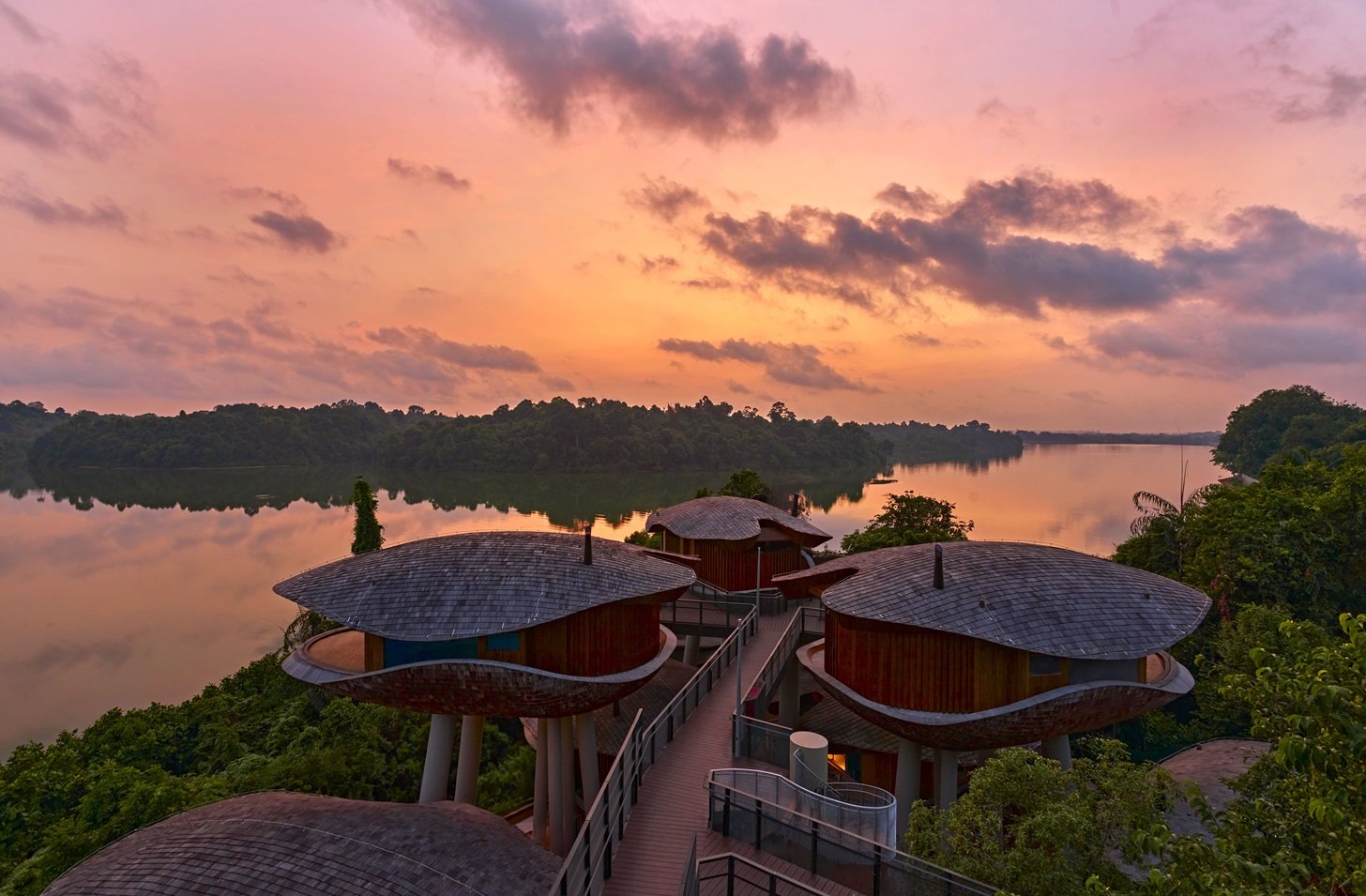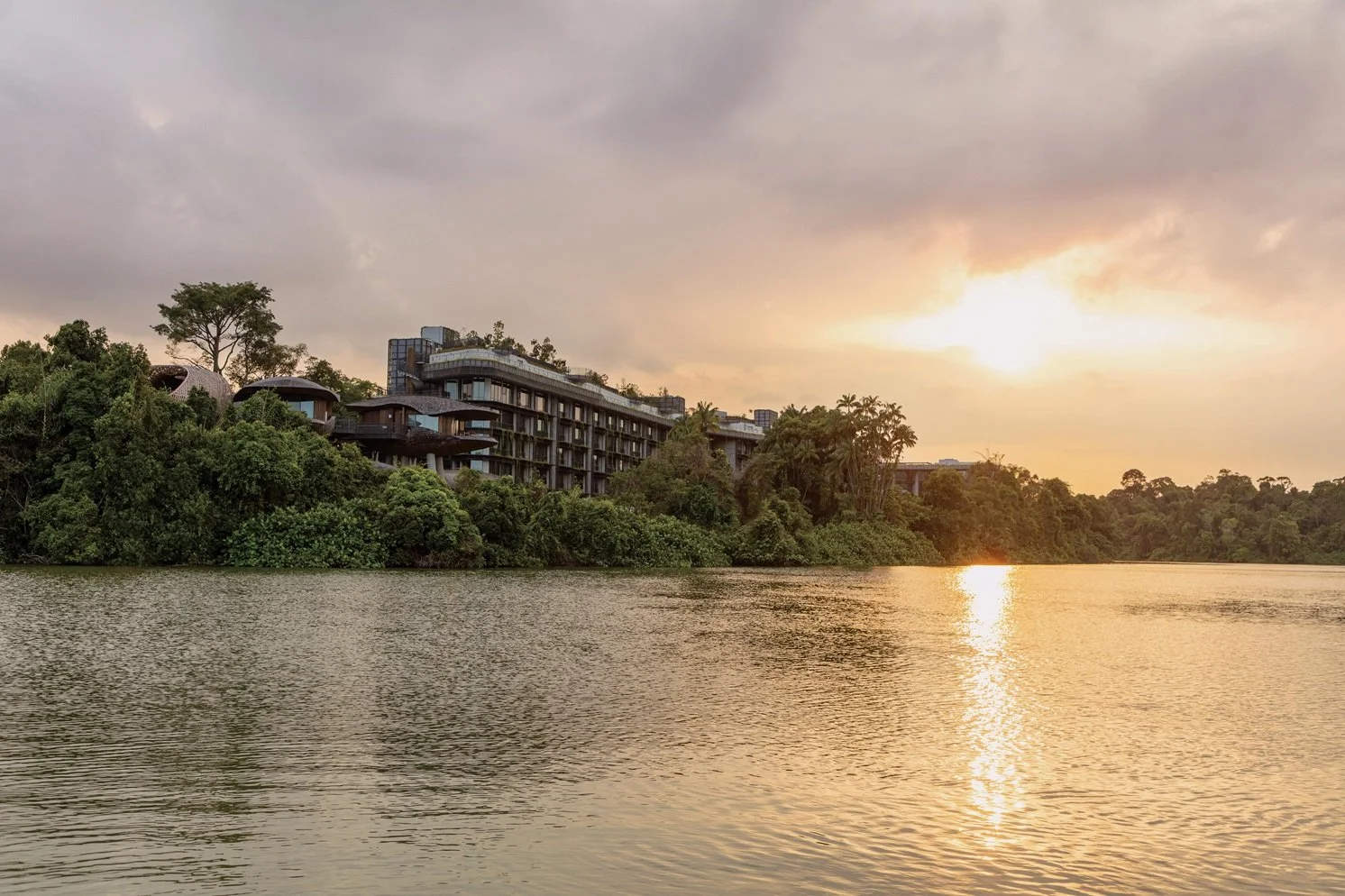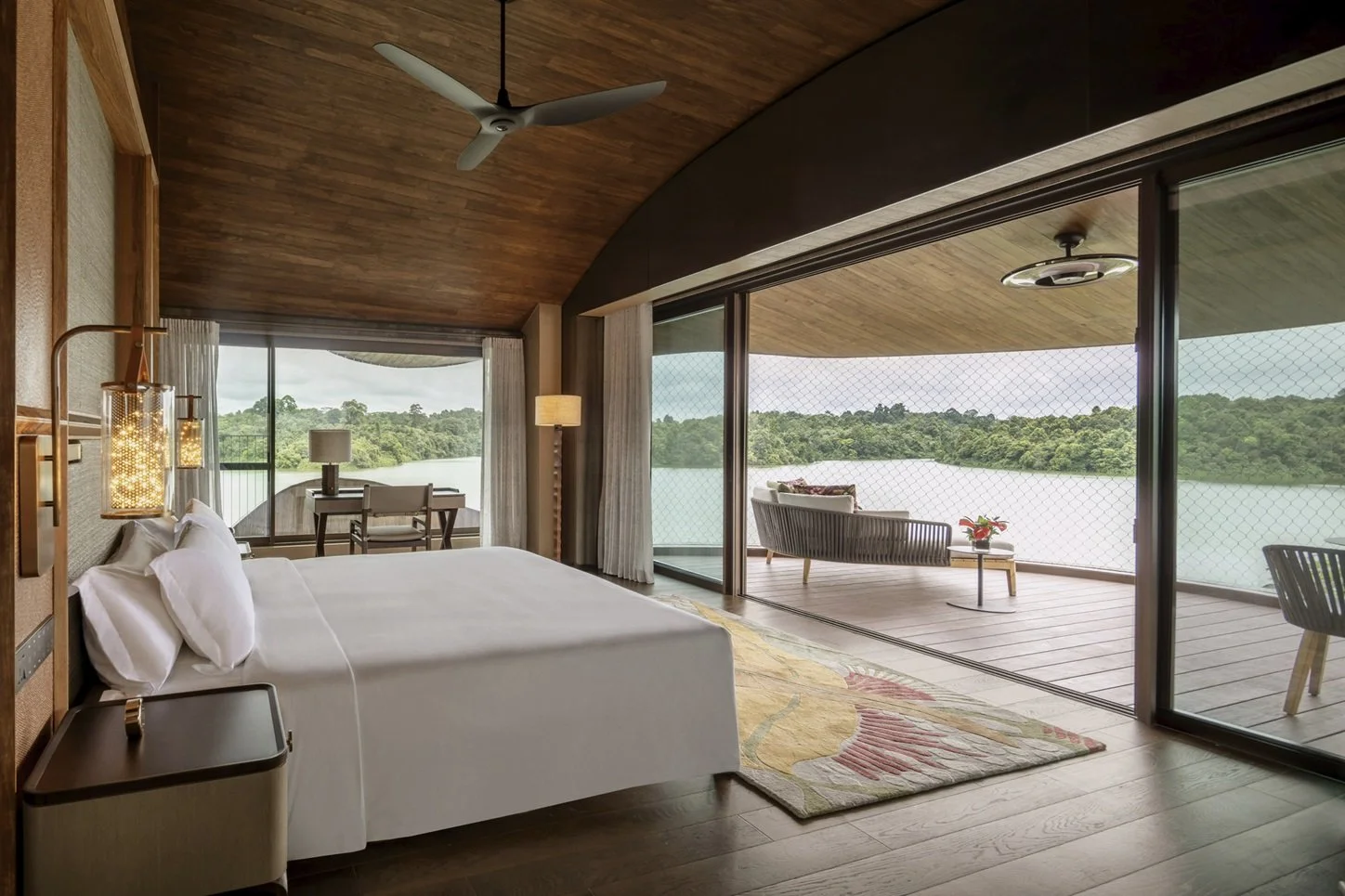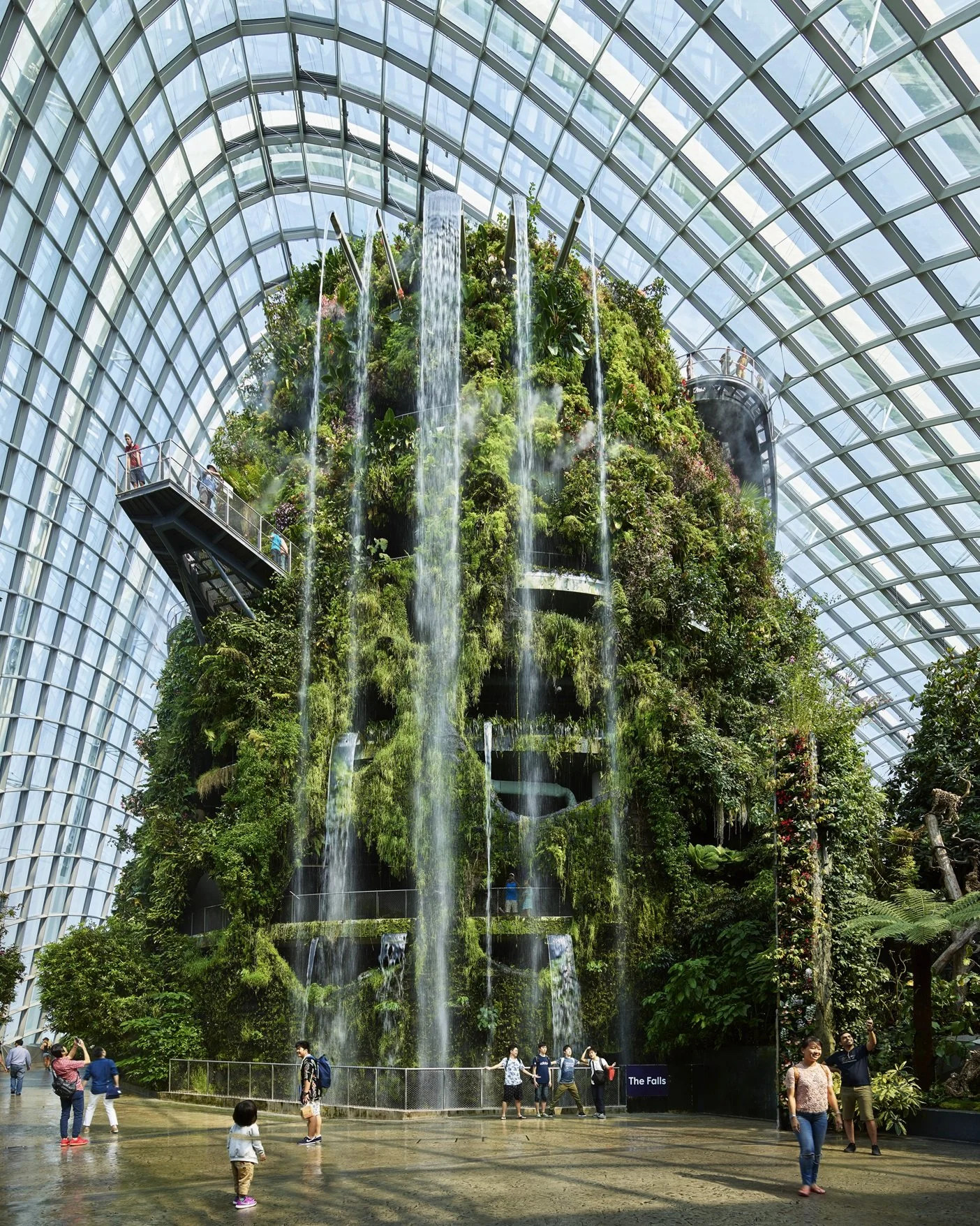Designing Desire: The Business and Wellness Case for Biophilic Hospitality
Photo by Capella Ubud, Bali
Hospitality has long been measured by its ability to provide comfort and luxury, but things are changing. With the rise of biophilic design, guests now want more than just a place to stay. They are looking for spaces that bring them closer to nature and rejuvenate them. It's now about blending the natural world into architecture and creating experiences that go beyond the built environment.
This article explores the core principles and growing importance of biophilic design, highlighting its benefits and successes. It offers hospitality professionals a practical guide to creating spaces that deeply resonate with guests while promoting sustainability.
What is Biophilic Design and Why Does it Matter?
Matthew Potter, Board Director of WilkinsonEyre, explains that biophilic design is "centered on reconnecting people with nature in the built environment (with well-documented impacts on human health, productivity, and well-being) but we like to consider it as part of a wider, holistic approach to sustainable design: the optimization of natural light and ventilation in low-energy buildings; the use of low-carbon materials; the integration of meaningful landscape that is rich in biodiversity and the making of spaces and places that are both restorative for their users and regenerative for the environment."
He emphasizes that there's no one-size-fits-all solution, but people value spaces that balance light, temperature, and wellness-focused design. Guests seek inviting, restorative environments that align with their circadian rhythms, featuring natural light, fresh air, and seamless indoor-outdoor connections.
Fundamental Principles of Biophilic Design
Natural Materials with Sensory Depth
Ozge Fettahlioglu (a.k.a. "Madame Cocoplum"), Wellness/Biophilic Interior Designer and Creative Director of Cocoplum Wellness Design, shares their company’s approach of using hand-oiled timbers, salt bricks, and travertine not simply for aesthetics, but for their tactile, sensory, and even olfactory properties. These natural materials engage the senses, creating an environment that promotes calmness, not just hosting but healing, leaving a lasting impression on guests.
"Luxury isn't loud. It whispers—and your nervous system never lies."
Live Greenery—Adapted and Localized
Cedric Jaccard, Founder and Creative Director of Avalon Collective, points out that not every region or project can support live plants in the traditional sense. In tropical places like Singapore, where a humid climate and heavy reliance on air conditioning pose challenges for indoor live plants, they turn to naturally preserved botanicals.
"These require no sunlight or watering, yet retain their lush, green appearance over time. It's a thoughtful solution that supports energy efficiency, while delivering a calming, nature-infused atmosphere that feels authentic to our context," Jaccard notes.
Hilton Singapore Orchard’s meeting spaces. Photo by Avalon Collective.
Jaccard believes that the real value of biophilic elements lies in the way they are designed—to be easy to maintain while still providing an authentic connection with nature.
"Maintenance is often the biggest concern. But biophilic design has evolved; there are now creative, low-maintenance solutions that still offer the sensory and emotional benefits of nature. Hoteliers can create immersive, natural environments without adding operational complexity."
Passive Design for Light, Air, and Water
Clint Nagata, Founder and Creative Partner of BLINK Design Group, says their approach goes beyond simply adding plants to spaces. "We integrate natural materials, maximize natural light, incorporate water features, and create seamless transitions between indoor and outdoor environments."
Their Six Senses Kyoto project embodies this philosophy through the central courtyard garden, natural materials such as Sudare bamboo blinds and Sakan plasterwork that connect guests to Japan's architectural heritage, and a design that spotlights the beauty of the surrounding landscape.
"We designed the central courtyard as a lung for the entire property, then complemented it with vertical gardens, strategically placed skylights, and hanging plants throughout the interior spaces. We also incorporated views that frame the surrounding mountains and seasonal changes, allowing guests to connect with Kyoto's broader natural context even from within the urban environment."
Six Senses Kyoto. Photo by BLINK Design Group.
Cultural and Contextual Authenticity
Fettahlioglu notes that authenticity arises naturally when design interacts with its environment. "I always start by deeply understanding what's already there—the landscape, climate, materials, and local culture—and then intentionally embed these elements into the sensory fabric of the space."
A resort in Los Roques National Park in Venezuela, for instance, Cocoplum created an overwater experience intimately connected with its pristine natural surroundings. Floor-to-ceiling windows offer panoramic ocean views, while glass flooring reveals marine life gliding beneath. Locally sourced natural materials reflect the tropical setting, creating moments of quiet awe and lasting emotional connections through authentic, sensory-rich experiences.



Case Studies
A Vertical Urban Sanctuary Rooted in Heritage
Artyzen Singapore exemplifies biophilic innovation in one of Asia's most vibrant retail and business districts.
"Biophilic design isn't just a feature—it's part of who we are and how we approach hospitality," says Marcel NA Holman, General Manager. As a newly built hotel (completed in 2023), it was designed with intention, paying tribute to the heritage of the former Villa Marie and Singapore’s identity as a garden city. The hotel aims to create a vertical oasis on Orchard Road, offering guests a connection to nature and a sense of nourishment from their surroundings.
“We thought about it holistically, weaving the experience through every part of the hotel—high ceilings and floor-to-ceiling windows that flood the interiors with natural light, planted terraces and open-air corridors that bring in fresh air and a sense of calm, and spaces like our 94-square-metre Terrace Suite with its private sky garden, which has become one of our most iconic features.”
The dining outlets also embrace nature, such as Café Quenino and The Roof Garden, both offering open-air views of the city skyline and sunsets.




Photos by Artyzen Singapore
"We invested in this design ethos because it reflects what we stand for as a brand—creating spaces that truly care for people and place, and deliver a sense of emotional connection. It's something guests remember. Many tell us they leave feeling refreshed and inspired, which is exactly the kind of impression we want to make," shares Holman. "Of course, it takes work to maintain—from integrated irrigation systems to a dedicated landscaping team—but it's part of the craft and care that defines the Artyzen experience."
Low-Impact Immersion: Jungle Luxury through Respectful Design
Capella Ubud, Bali is a case study in unobtrusive, immersive biophilic design. Conceptualized by renowned architect Bill Bensley, the resort was never designed to dominate the landscape; rather, it was intended to blend seamlessly into the surroundings.
Not a single tree was cut during the camp's construction. The resort overcame logistical challenges in preserving the natural landscape by using manual labor instead of heavy machinery, ensuring minimal disruption to the terrain. Elevated tented accommodations are thoughtfully nestled within the natural canopy, resonating with the Balinese respect for land and life.




Capella Ubud, Bali is a living example of how biophilic design can create harmony between built environments and the natural world. Photos by the resort.
"Guests consistently remark on the feeling of being cradled by nature, with floor-to-ceiling views of lush foliage, the sounds of the river below, and natural ventilation that connects them to the rhythms of the jungle," shares General Manager Christian Jaquier.
"The sense of privacy and immersion is both grounding and rare. We believe it resonates because it offers a complete sensory escape from modern life—a kind of luxury defined not by opulence, but by connection," he adds.
Financially, Capella Ubud, Bali benefits from reduced operational costs. Natural airflow reduces air conditioning needs while its landscaping relies on native, drought-tolerant species that require minimal maintenance. These sustainability-led practices not only lower costs but also enhance the guest experience by creating a more authentic connection to the environment.
A High-Rise Oasis: Connected, Productive, Green
CapitaSpring, a 51-storey integrated development in Singapore, which houses the 299-unit serviced residence Citadines Raffles Place Singapore, proves that biophilic design can flourish even amidst skyscrapers.
The four-story, 35-meter-high "Green Oasis" is a rare sanctuary in the CBD of Singapore, sheltering over 38,000 plants (more than 63% of which are native).
Giovanni Cossu, Head of Sustainability at CapitaLand Development, explains that strategic plant placement was planned to ensure sufficient sunlight for the green landscape. Inspired by tropical rainforests, the Green Oasis features plants selected for their ability to thrive in specific light conditions. Upper levels feature smaller, open-branch plants that facilitate wind passage, while lower levels house shade-tolerant plants with larger, denser leaves. Complementary trees and shrubs add layered visual interest.
Design strategies at Citadines Raffles Place Singapore incorporate passive cooling, including facade fins that reduce solar radiation and promote ventilation, as well as an optimized wall-to-window ratio to maximize daylight without excessive heat gain.
Guests of Citadines Raffles Place Singapore can retreat to a 312-metre-long botanical promenade, relax in garden nooks, or enjoy produce from Sky Garden on level 51 rooftop—Singapore's highest urban farm, which supplies fresh produce to a farm-to-table concept at two F&B concepts in CapitaSpring.



The open-air setting creates a sensory experience uncommon in urban hospitality, with fresh air, natural daylight, and curated planting providing a cooling effect and mental reset. Photos by CapitaLand.
Living Heritage: Melding Culture, Ecology, and Community
Mandapa, a Ritz-Carlton Reserve in Ubud, Bali, offers a living lesson in designing biophilic spaces that go beyond mere aesthetics to become cultural landmarks. Inspired by local village forms, the resort integrates rice paddies, rainforest, and the sacred Ayung River into its setting.
Mandapa preserves approximately 13 acres of rainforest in agreement with local villages—an active approach to both ecological and cultural conservation.



Photos by Mandapa, a Ritz-Carlton Reserve
"For irrigation of our paddy fields, we use recycled rainwater and the Subak irrigation system, a traditional water management method in Bali recognized as a UNESCO World Heritage site."
Jeffrey Wilkes of DESIGNWILKES masterfully blends elements from Bali's 11th-century Gunung Kawi fountains and the Tirta Empul Temple into the design. Inspired by the vibrant colors of Balinese floral offerings, 'Canang Sari,' the interiors feature hues of lime, marigold, magenta, and rich coffee tones, complemented by weathered panels for a timeless aesthetic.
"The beautifully painted murals, unique in every location, tell intriguing stories of the landscapes and their people, honoring local artisans," shares Aminath Rausha, Director of Marketing and Communications. "Our architecture blends harmoniously with the environment, offering guests views of rice paddies, rainforest, or rivers at every turn," she adds.
The Mandapa Camp, the kids' club designed with sustainable bamboo and shaped like a whale, invites children to connect with nature and disconnect from technology. Surrounded by cows, hens, roosters, and ducks, the young guests can experience life like a Balinese child.


Mandapa Camp. Photos by Mandapa, a Ritz-Carlton Reserve.
Island Regeneration: Bamboo Innovation and Off-Grid Living
No property demonstrates low-impact luxury quite like Cempedak and Nikoi Private Islands.
"When we started our journey back in 2004, no one was even talking about biophilic design. Our approach was rooted in a simple philosophy: a desire to be close to nature. During the early development days, we camped on the islands, which gave us a true understanding of what living in nature is like, including the challenges of operating through adverse weather," shares Andrew Dixon, Co-Founder of Cempedak and Nikoi Private Islands.
This experience inspired some of their sustainable design choices. For example, the dining room features a sand floor, which is both cost-effective and environmentally friendly.
Over time, "we've come to realize just how much our guests value this connection to nature, as they love sitting at our large driftwood tables, feeling the sand beneath their feet, while the younger ones stay entertained building sandcastles."
The villas are open to the environment, offering stunning views and ocean breezes. Double-layered, grass-thatched roofs naturally cool the space, eliminating the need for air conditioning.
"Our designs incorporate locally sourced materials such as driftwood, bamboo, and alang alang grass, which not only create a strong sense of place but also reflect the strong cultural heritage of the local area and region," says Dixon.




Photos by Cempedak Private Island
Cempedak and Nikoi islands operate on solar energy and consume less than 400 kWh per day, roughly equivalent to running eight hairdryers. "In a typical luxury hotel in the tropics, electricity can account for approximately 45% of the total energy bill, but for us it is virtually zero," shares Dixon.
The islands also achieve significant water conservation by propagating native plants, eliminating the need for watering their gardens, except for their vegetable patch and grass tennis court.
"The biggest challenge has been convincing potential guests that it's possible to sleep comfortably in a non-air-conditioned room in the tropics. Focusing on using high-quality organic cotton linen and draping the beds in mosquito nets with a fan cleverly installed inside, in villas especially designed to invite natural ventilation, has helped overcome this," explains Dixon.
Restorative Retreat amid Wildlife and Forest
Mandai Rainforest Resort by Banyan Tree in Singapore offers an urban escape deeply embedded in nature. Part of Mandai Wildlife Reserve, the resort embraces biophilic design "to create a restorative guest experience that coexists in harmony with nature."
"We are the first resort in a world-leading nature and wildlife destination in a capital city, where travellers can immerse themselves in the wonders of biodiversity on their doorstep," says Hotel Manager Shereen Chow.
The resort's architecture draws inspiration from the layered complexity of the rainforest, with elevated structures designed to minimize ground disturbance and protect wildlife, as well as re-greening efforts aimed at helping restore the ecology. The chosen materials and open spaces blur the boundaries between indoor and outdoor, allowing guests to connect with nature.
The project initially intended to use mass timber construction but shifted to precast concrete due to Singapore’s humid, tropical climate and long-term durability requirements. Fallen trees from the site were not discarded. They upcycled the bark into rubber molds that bring rainforest textures into the built environment. Local artisans reconstituted the wood for treehouse cladding and repurposed selected hardwood species into bespoke furniture.




Designed by the local firm WOW Architects, the elevated treehouses exemplify biophilic design in action. Photos by Mandai Rainforest Resort by Banyan Tree
Over half the original trees—40% of which are conservation species—were retained during construction. “A majestic Rain Tree and a native Indian Beech are two iconic heritage trees that we retained,” shares Chow. “Both are central to the resort’s biophilic design, reflecting our commitment to harmonizing architecture with nature. The Rain Tree’s broad canopy evokes the rainforest, while the hardy Indian Beech supports a thriving habitat for local flora and fauna.”
The resort incorporates passive design strategies, such as natural ventilation, mixed air conditioning, and solar panels. The 24 treehouses will also feature passive displacement ventilation, which cools air using chilled water rather than traditional air conditioning compressor units.
"These features contribute to overall energy efficiency and improved thermal comfort, and we are proud to say that Mandai Rainforest Resort by Banyan Tree is the first resort to be awarded Singapore's Green Mark Platinum Super Low Energy. This means we have ensured the total energy usage is 40% less than equivalent properties," says Chow.
Wellness-Driven Urban Hospitality: Nature-Infused Tranquility
The Westin Yokohama reimagines wellness in an urban setting. The design intent is clear: to create a "forest bathing" experience with living green walls as the highlight of the reception and open-roof meeting spaces.
Guestrooms feature automatic blinds that let in the light as guests enter, and the entryway of each room has a dappled lighting effect, as if sunlight is shining through leaves. “This is our 'shinrinyoku' (forest bathing),” notes Gabrielle Doman, The Westin Yokohama's Hotel & Restaurant Marketing Manager.
The hotel also features ocean-inspired carpet and coral-inspired art that nods to Yokohama's portside history.
"Unlike most hotels, we don't have floral displays. Instead, we have greenery and local art throughout, which helps promote a sense of calm," says Doman.



Photos by The Westin Yokohama
"This year, we became the first hotel in Kanagawa Prefecture to receive the Green Key, a global eco-certification run by the Foundation for Environmental Education (FEE). Green Key is an international environmental certification used for hotels and tourist facilities, meaning they meet strict environmental standards, such as energy savings, waste reduction, sustainable procurement practices, and environmental education initiatives," shares Doman.
Restoring Island Biodiversity
Six Senses Yao Noi is known for its regenerative landscaping and biodiversity.
Graham Grant, General Manager, says, "From the moment guests arrive, Six Senses Yao Noi surrounds them with nature's rhythm. Lush greenery, cooling breezes, and hand-built villas crafted from local, renewable materials. Our design is rooted in biophilic principles, incorporating features such as passive cooling and natural ventilation, as well as regenerative landscaping that attracts hornbills and nurtures biodiversity."
Grant adds that by using passive cooling, recycled materials, and native vegetation, they have reduced long-term operational costs while creating spaces that guests return to and recommend "because they feel different: authentic, nourishing, and alive."
"Our guests often mention the calming effect of our open-air villa bathrooms, natural wood textures, and floor-to-ceiling views of Phang Nga Bay. These elements create a seamless connection between indoor comfort and the island's raw beauty, offering a sense of freedom, privacy, and grounding."
The use of local craftsmanship, low-impact materials, and energy-saving practices is not just an environmental win, but a strong business driver. Their return guests cite the feeling of "belonging that only comes from true harmony with the land."




Photos by Six Senses Yao Noi
Expert Recommendations – The Practical Road to Biophilic Adoption
The potential of biophilic design is vast, but successful implementation requires more than inspiration—it takes strategic alignment with operational goals and local ecosystems. Here's how hospitality professionals can get it right, backed by expert advice.
1. Start with foundational simplicity.
Even small biophilic interventions can have a significant impact when executed thoughtfully.
Start small, but think holistically. Ozge Fettahlioglu recommends incorporating natural light strategically, adding greenery thoughtfully, and employing textures that guests instinctively want to touch. Even a single, carefully chosen scent can dramatically shift the guest experience. Use these sensory elements as powerful entry points to bigger shifts.
Bring nature in with intention. Christian Jaquier advises starting by bringing nature in. “Biophilic design isn’t about extravagance—it’s about creating moments of stillness and connection,” he says. Subtle shifts—like introducing natural light, organic materials, local plants, or natural ventilation—can have a profound emotional impact. Focus on spaces where guests naturally pause, such as lobbies, restaurants, and guest rooms, and let nature do the rest.
Photo by Capella Ubud, Bali
Connect guests to light, air, and greenery. Marcel NA Holman emphasizes the importance of intention. “Look at how your spaces can better connect guests to light, air, and greenery, and start there. Even small, thoughtful changes can nourish the senses and transform spaces into sanctuaries where guests feel grounded and cared for.”
Bring the outdoors in. Shereen Chow echoes this sentiment. “Introduce native plants and greenery that naturally belong to your environment, and prioritize natural light wherever possible. These aren’t structural overhauls, but they have a transformative effect on atmosphere and guest experience.”
Let the landscape guide your design. Graham Grant adds, “Prioritize local, natural materials. Even simple steps—like incorporating native plants or opening up spaces to daylight and air—can create powerful moments of connection.”
Photo by Six Senses Yao Noi
Make biophilic design intrinsic to the architecture. Matthew Potter stresses the importance of 'baking in' (not just applying) biophilic design as an intrinsic part of the architecture to create spaces where both plants and people can thrive. He advises to "build nature into buildings in a way that is meaningful, viable, and sustainable.
"We need to reconnect with the natural world and find a better balance in our cities and built environment that isn't just 'less bad' but is actually positive and even regenerative. We are living in a time of biodiversity crisis, and creating landscaped, outdoor spaces that are filled with native plants is a vital part of biophilic design."
Matthew Potter’s Cooled Conservatories project at Gardens By The Bay showcases rare and endangered plants from around the world, thriving in sustainable, carbon-neutral glasshouses. This innovative design overcomes Singapore's tropical climate, creating an immersive experience for visitors while highlighting the importance of biodiversity. Photo by Kevin Scott.
2. Collaborate with local experts.
Biophilic design thrives on authenticity. By partnering with local artisans and environmental experts, properties can create culturally respectful spaces.
Clint Nagata's approach exemplifies this through projects that utilize authentic local materials, techniques, and artisans and craftspeople, connecting guests to the region's natural heritage.
At Six Senses Kyoto, "rather than using raw, unfinished materials, we worked with master craftspeople to create sophisticated interpretations of natural elements,” he shares. “Our bamboo elements include expertly crafted Sudare blinds, our plasterwork follows traditional Sakan techniques, and our gardens are designed with the precision of classical Japanese landscape architecture."
Six Senses Kyoto. Photo by BLINK Design Group.
3. Align design with maintenance needs.
One of the frequently overlooked aspects of biophilic design is maintenance planning. Without foresight, living walls or natural installations can become liabilities. Cedric Jaccard highlights, "biophilic design has evolved; there are now creative, low-maintenance solutions that still offer the sensory and emotional benefits of nature. Hoteliers can create immersive, natural environments without adding operational complexity."
With modern advancements like preserved botanicals and adaptive lighting, Jaccard adds that biophilic elements can thrive even in low-light, indoor spaces. "The key is to approach it as an integral part of the overall design narrative, not just a decorative feature."
At Hilton Singapore Orchard, the use of preserved greenery eliminates irrigation needs while lowering maintenance efforts—a simple yet impactful approach that balances aesthetics with functionality.
4. Educate and inspire internal stakeholders.
"Biophilic design is creating spaces that fundamentally reconnect people with nature to promote health, well-being, and reduced stress," explains Nagata. "Design that reconnects us with nature – biophilic design – is essential for providing people opportunities to live and work in healthy spaces with less stress and greater overall health and well-being."
Fettahlioglu adds, “Consider your space as a living ecosystem that guests move through—each touchpoint should silently communicate well-being, calm, and authenticity. Remember, biophilic design isn't an aesthetic upgrade; it's an investment in your guests' health, your staff's productivity, and your property's lasting value.”
Businesses looking to embed biophilic designs must invest in employee training for sustainability.
The Future of Biophilic Design
When asked about the future of biophilic design in the hospitality industry, Nagata believes that "we're moving toward a kind of 'immersive naturalism'—where biophilic design becomes more sophisticated and integrated into the fundamental architecture of spaces rather than being an add-on feature.
"I strongly believe the next big movement in design will be biophilic design, and this will be driven by increasing awareness of wellness and sustainability.
"We'll see more properties incorporating living architecture—walls that breathe, water systems that purify air, and spaces that actually contribute to urban biodiversity. Technology will also play a role, with smart systems that optimize natural light, air quality, and acoustic environments to enhance human well-being.
The luxury hospitality industry will increasingly recognize that true luxury isn't about opulence, but about creating spaces that make people feel fundamentally good—physically, mentally, and spiritually. Biophilic design is essential to achieving this goal."












